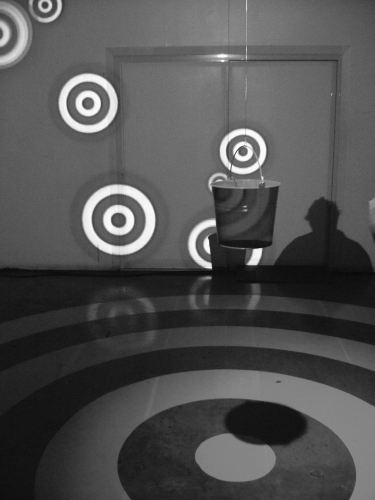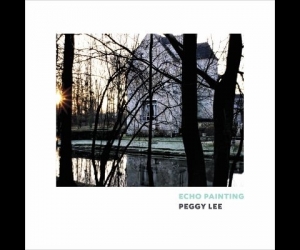
This year’s festival was defined in its earliest moments, when audiences were treated to the finest A/Visions experiences in recent memory. A/Visions, an audiovisual showcase, has always been a highlight of the festival and the natural silence of the theatre provides an engaging listening atmosphere, free of distraction. In this setting Wolfgang Voigt premiered GAS, a stunning audio-visual presentation of his critically acclaimed experimental ambient works. For ninety minutes Voigt stood in darkness to the left of the giant screen, where he worked invisibly to create a haunting dreamscape of ambient drones, delicate washes, and pulsating rhythms. The rich textures of the music were mirrored on the giant screen next to him, where tangled, fibrous images of Germany's Black Forest morphed through colour and space in synchronicity with the soundtrack. The combination made for an unforgettably visceral experience, and proved to be one of the standout shows of this year's festival.
Next at A/Visions was Herman Kolgan’s world premiere of IN/JECT, a conceptual exploration of a nude human figure submerged in water. The dispassionate, macroscopic images of the figure losing air created a sense of tension and eerie suffocation while suggesting that the specimen was being examined scientifically. The imagery, juxtaposed with the jarring and unsettling soundtrack of clicks and cuts, left a strong emotional impression of displacement, informed by the artist's recent loss of his mother.
The quality and beauty of GAS and IN/JECT set the tone and standard for the rest of the festival. The Fun Years delivered an effortless fusion of beautiful reverberating acoustic warmth with fuzzy crackling nostalgic ambience, and was paired with the gorgeously distorted live visuals of Justin Manor, a member of Sosolimited. Legendary Jaki Liebezeit’s trance-inducing rhythms melded with Burnt Friedman’s jazzy dub to deliver an exciting, spiritually primitive, gleeful set. Sheffield's SND performed a stripped-down minimal techno set full of tight percussive pulses, static clicks, and fluid organic tones. Non-Standard Institute's highly crafted, minimal, atmospherically dark set accompanied videographer Jimmy Lakatos’ abstract shooting-star visuals to create an otherworldly experience.
The Raster Noton label, known for its futuristic and disciplined aesthetic, capped A/Visions with a label showcase. Minimalist masters Ryoji Ikeda and Carsten Nicolai kicked it off with Cyclo: an erratic set full of glitchy loops and buzzy pops layered with subtle rhythmic frequencies. Eccentric legend Uwe Schmidt (a.k.a. Atom Heart, among other monikers) performed as Atom™. Schmidt stood completely still while his tracks played themselves, rendering the set more of a self-conscious performance-art piece than a concert. His quirky delivery made me lose focus on the music as I become more fascinated with his unpredictability and cheeky visuals. Internationally renowned sound artist Carsten Nicolai returned to the stage under his Alva Noto moniker, delivering an intricate minimal set transcended with fuzzy white noise. Olaf Bender (a.k.a. Byetone) stole the show with his rock-driven minimal techno set. Byetone’s tightly pronounced percussive patterns weaved and climaxed to the point of feverish insanity.
Robert Henke and Christopher Bauder’s prestigious ATOM installation took place at Place des Arts. The crowd was slowly escorted through a large dark hall into an exhibit room, illuminated only by the glow of sixty-four helium-filled red balloons centred in the middle of the floor. Suppressing the desire to start singing “99 Red Balloons,” I watched in surprise as the balloons changed from red to white and began moving around like dancing cloud formations, tightly synchronized with the atmospheric ambient techno compositions. Each balloon was attached to a motorized cable that would individually fluctuate in space. The effect was mesmerizing and unique, making the exhibit another creative highlight of this year’s MUTEK.
The better-known artists played the Nocturne showcases, which were mostly held in Metropolis, the largest performance space of the festival. Off to on side the Savoy Room featured experimental or label-focused performances. One of the highlights in the Savoy Room was New York-based Anticipate label-owner Ezekiel Honig. His unique voice brings a new level of richness to minimal ambient techno. His taste for weaving layers and space combined with household field recordings and deep washes produces absolute bliss.
The festival was buzzing about the Canadian première of Moderat, the newly formed trio of Modeselektor and Apparat. The Berlin-based techno superstars ripped up a packed Metropolis theatre with an über-hip electro dubstep set, superbly produced with Apparat’s pop expertise and vocals.
Detroit-based techno pioneer Carl Craig took the stage at 3 a.m. Sunday morning, delivering a masterful set. His stoic godfather-type persona rocked the floor with creeping, subtle mixes that swung gently back and forth between soulful house and trance-inducing techno. His level of control and craftsmanship created an epic set full of Detroit classics.
Piknic Electroniks are always held on festival weekends at Parc Jean Drapeau under Alexander Calder’s Expo 67 statue Man. The first outstanding performance was Thomas Fehlmann’s schaffel infused dubby techno set that had dancers gleefully shaking it to his solid 4/4 structures and fluid capabilities under the gloriously warm sun. The second day the weather was less welcoming. Protecting themselves from the rain by holding blankets over their heads, people danced to esteemed Ricardo Villalobos and Perlon cofounder Zip’s tag-team seven-hour marathon set delivering some of the finest minimal dance floor rhythms, making MUTEK history.
Given MUTEK's stated purpose of developing a space where contemporary experimental electronic music and art meet, MUTEK_10 proved to be the most successful festival to date. Although for many festival-goers the boisterous Nocturne and Piknic events will remain the highlight of MUTEK, this year's A/Visions exhibits were the strongest and most memorable.
Wherever one’s personal tastes might fall, the sampling of so many multi-faceted, spectacular, and talented performers is the richest treasure MUTEK has to offer, and I hope it will continue in years to come to pay homage to the diversity and depth of the genre.


